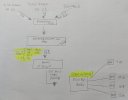Ok, thanks, I almost understand.Most likely the gain differences of the AVR channels will be done via the analog volume control chips after the DACs. Maybe they also tweak the volumes control of the DAC a bit.. hard to say. You may find out with a bit of experimentation.
It’s fixed. Note though that the MiniDSP will resample it again to its internal clock domain regardless of the input sample rate.
If you were in my place, with this audio scheme/chain, considering the Denon x3600h, with digital coax out at 48khz (I assume 24bit)...how would you set my Apogee Rosetta 200 converter at the input to the Denon? Also, would you run the 10x10 minidisp with 48khz or 96khz plugins? I attach a simple drawing.
Thank you

